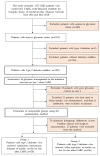Continuous Intravenous Insulin Infusion in Patients with Diabetes Mellitus After Coronary Artery Bypass Grafting: Impact on Glycemic Control Parameters and Postoperative Complications
- PMID: 40364261
- PMCID: PMC12073021
- DOI: 10.3390/jcm14093230
Continuous Intravenous Insulin Infusion in Patients with Diabetes Mellitus After Coronary Artery Bypass Grafting: Impact on Glycemic Control Parameters and Postoperative Complications
Abstract
Objectives: This study compared the efficacy of continuous insulin infusion therapy (CIT) versus standard bolus insulin therapy in maintaining optimal perioperative glycemic control in patients with type 2 diabetes mellitus (T2DM) undergoing coronary artery bypass grafting (CABG), focusing on postoperative outcomes. Methods: In this single-center, open comparative study, 214 T2DM patients were selected from 1372 CABG cases (2016-2018) and divided into CIT (n = 28) and bolus therapy (n = 186) groups. Both groups were matched for sex, age, smoking status, body mass index, functional class of angina or heart failure, surgical characteristics and preoperative HbA1c. The target glucose range was 7.8-10 mmol/L (140-180 mg/dL), consistent with current guidelines. Glycemic control was assessed through frequent postoperative measurements, with particular attention to glucose variability and hypoglycemic events. Results: The CIT group demonstrated superior glycemic control, with significantly lower median glucose levels at 7, 8, 10, 12, and 13 h post-CABG (p < 0.05). Glycemic variability was reduced by 32% in the CIT group (p = 0.012), and the incidence of hypoglycemia (<3.9 mmol/L) was 3.6% versus 8.1% in the bolus group. While overall complication rates were similar, the CIT group had 0 cases of stroke, myocardial infarction, or wound infections versus 2.7%, 3.2%, and 5.9%, respectively, in the bolus group. Logistic regression confirmed that each 1 mmol/L increase in first-day glucose levels independently predicted both significant (OR 1.20, 95% CI 1.06-1.36) and serious complications (OR 1.16, 95% CI 1.03-1.30). Conclusions: CIT provided more stable postoperative glycemic control with reduced variability and hypoglycemia risk in T2DM patients after CABG. Although underpowered to detect differences in rare complications, our findings suggest CIT may improve outcomes. These results warrant validation in larger randomized trials.
Keywords: perioperative glycemic management; postoperative complications; short-acting insulin; type 2 diabetes mellitus.
Conflict of interest statement
The authors declare no conflict of interest.
Figures








References
-
- Ivanov S.V., Sumin A.N. Current trends in routine myocardial revascularization. Complex Issues Cardiovasc. Dis. 2021;10:25–35. doi: 10.17802/2306-1278-2021-10-2-25-35. - DOI
-
- Cosentino F., Grant P.J., Aboyans V., Bailey C.J., Ceriello A., Delgado V., Federici M., Filippatos G., Grobbee D.E., Hansen T.B., et al. 2019 ESC Guidelines on diabetes, pre-diabetes, and cardiovascular diseases developed in collaboration with the EASD. Eur. Heart J. 2020;41:255–323. doi: 10.1093/eurheartj/ehz486. - DOI - PubMed
LinkOut - more resources
Full Text Sources

